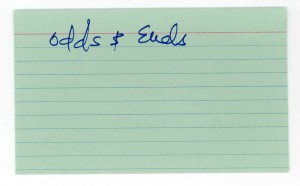Falling In
Last weekend we had guests so I cleaned up the back room and put all the family papers away in the closets. There is a lot of stuff – letters, postcards, photographs. This stuff tells lots of different stories. I can trace families or individuals. I can trace business transactions or birthdays. I can string together a line of unpaid bills or read the heartbroken account of the end of a long love affair. All these stories are illustrated by innumerable photographs of dinner parties and porch parties and hikes and tennis games and travels. When I start to work on the material, I get lost. I love it when I’m there, but when I’m not there the knowledge that all that stuff is up in my closets makes me anxious. I have to figure out a way to make it okay to fall in. It seems overly indulgent navel gazing to just look at my family stuff. How do I make it something more than just genealogy or family story-telling? Or is it okay if that’s what it is?  I don’t quite know where to place myself in relation to the things and the stories that ooze out of them. Am I an archivist, whose job it is to describe, count, and place in acid-free folders? Am I an historian, whose job it is to place these people, many of whom I actually knew and some of whom I love dearly, in a cultural context? Is it my job to write down the stories so the rest of my family knows them? Is it my job to make a new narrative out of the stuff? I just don’t know. I do know that I have fun when I fall into the material. Hours go by. Time stops. It’s full and rich and textured and real, but that isn’t quite right.  It isn’t complete; it can never tell the truth.  And I miss the people who made these things very much. I want them to be here to answer my questions. “Were you really a spy?”  “What was biking through Bavaria in 1924 like?”  But the questions I have I probably could not have asked or I probably would have when I had a chance. I just don’t know. Today I miss not having the chance.
